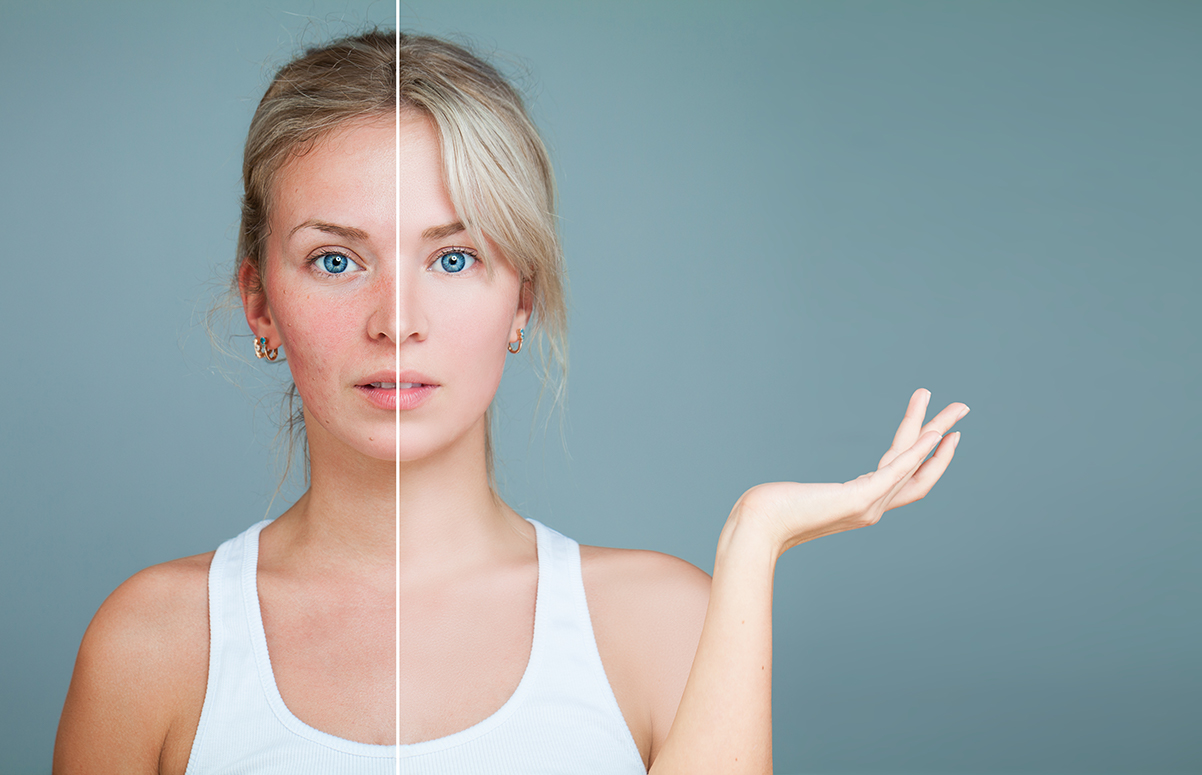
Rosacea is a common skin condition that can be very embarrassing and impair quality of life. It tends to flare up periodically in between periods of remission. During a flare-up, it can cause reddening of the face, the appearance of visible red blood vessels, a rash, pus-filled red bumps, and a feeling of heat and tenderness in the facial skin. In around 50% of patients, eye dryness and irritation can occur during a flare-up. As the condition progresses, facial redness can become permanent in between flare-ups. In rare cases, mostly in affected men, the skin of the nose can thicken and appear bulbous. Despite being quite common, few people have heard of rosacea, and most people mistake it for acne, allergic reactions, or even a chronic drinking problem.
The severity of the condition is measured using an established system that grades the severity of each of the symptoms on a scale of 0 (absent), mild (1), moderate (2), or severe (3). The assessment of each symptom is then combined into a global score of mild, moderate, or severe disease. Most patients initially manifest with mild symptoms, and while some patients may continue to have mild symptoms for many years, others gradually progress and develop increasingly severe symptoms over time, especially if they do not seek treatment.
The typical person affected is a middle-aged woman with a fair complexion, but it can affect both men and women of any age, even adolescents, and also affect individuals with darker complexions. The cause of the condition is unknown, and it does not lead to serious health problems, but it can cause distress, discomfort, and a reduced quality of life in victims. Smoking, fair skin, being over 30 years of age, and excessive exposure of the skin to the sun or tanning beds may increase the risk of developing rosacea; there may be a genetic link as well, since it often seems to run in families.
What are the Triggers?
Flare-ups are commonly triggered by the following:
- Stress
- Exposure to the sun or strong winds
- Exposure to extreme cold or extreme heat
- Exercise
- Some cosmetics
- Some medications
- Eating spicy foods
- Consuming alcohol
However, in many cases, no cause for flare-ups can be identified. Individuals who are able to identify a common cause of their flare-ups can try to avoid the cause and, thus, reduce their incidence of them.
What are the Available Treatments?
There is currently no cure for this condition. Treatments generally revolve around reducing and controlling symptoms. Topical medications such as brimonidine, azealic acid, and metronidazole can reduce the redness of the skin and relieve some symptoms.
BBL Treatment for Roseacea
All of the above mentioned treatments are only applied during flare-ups and can only shorten the duration and intensity of the flare-up, but they cannot reduce the incidence or risk of them or reduce the chronic redness of the face between flare-ups. Another approach is to use light based therapy or BBL Laser / Light based treatment, may be able to assist with these problems. BBL stands for broadband light. Conventional lasers produce only a single wavelength of light, but BBL devices produce a wide range of intense light wavelengths that deliver energy to the skin, pigmented areas, and visible blood vessels. Exposure of affected skin to BBL lasers can eliminate visible blood vessels and stimulate the body to produce more collagen and new, fresh skin. Most rosacea patients note that after a course of BBL laser treatments, their persistently red facial skin is no longer red and their blood vessels are no longer visible.
BBL Laser Treatment is Not a Cure
Although BBL laser treatment can improve the appearance of the skin during and between flare-ups, and can reduce the incidence of flare-ups, it is not a cure. Most individuals have the best results if they continue to use medications during flare-ups in conjunction with BBL laser treatments, as well as trying to avoid triggers.
The Treatment Process
A hand-held device is used to deliver the intense broadband light energy to the facial skin. The eyes are protected during the treatment. The full extent of each treatment will not be apparent until weeks after each session, and the appearance of the skin will continue to improve over time and after repeated treatments. Patients can immediately return to their regular activities after each treatment with little downtime required.
Initially, a series of treatments is typically given. Thereafter, each patient can develop a protocol for maintenance treatments to control their condition. Some patients continue to need monthly BBL laser treatments, while others may only need a treatment once every so often. It all depends on the unique case.
Back to Blog
All Rights Reserved. Web Design & Internet Marketing by Studio III
